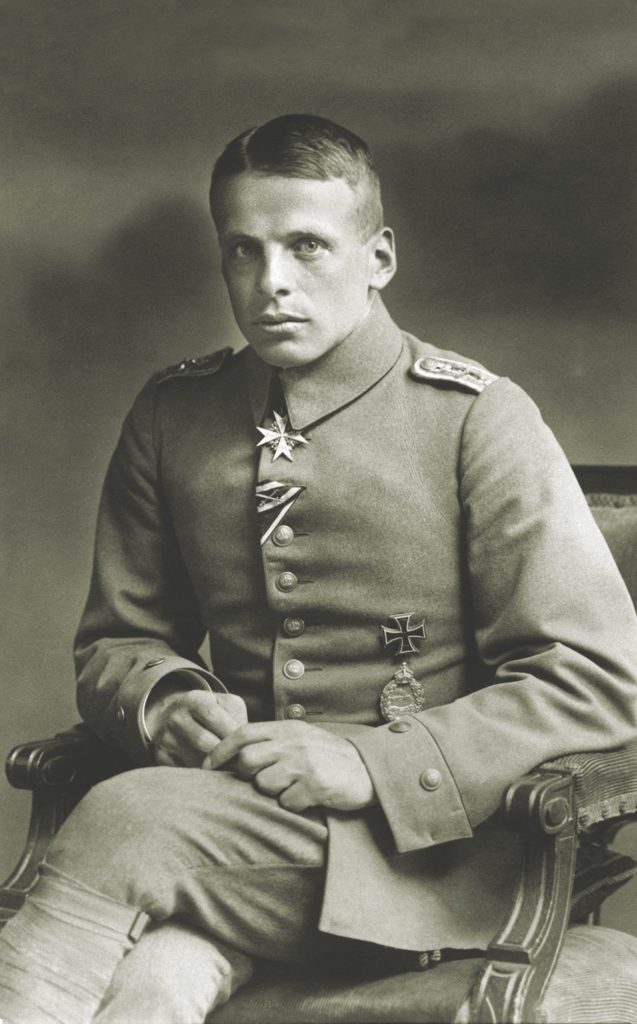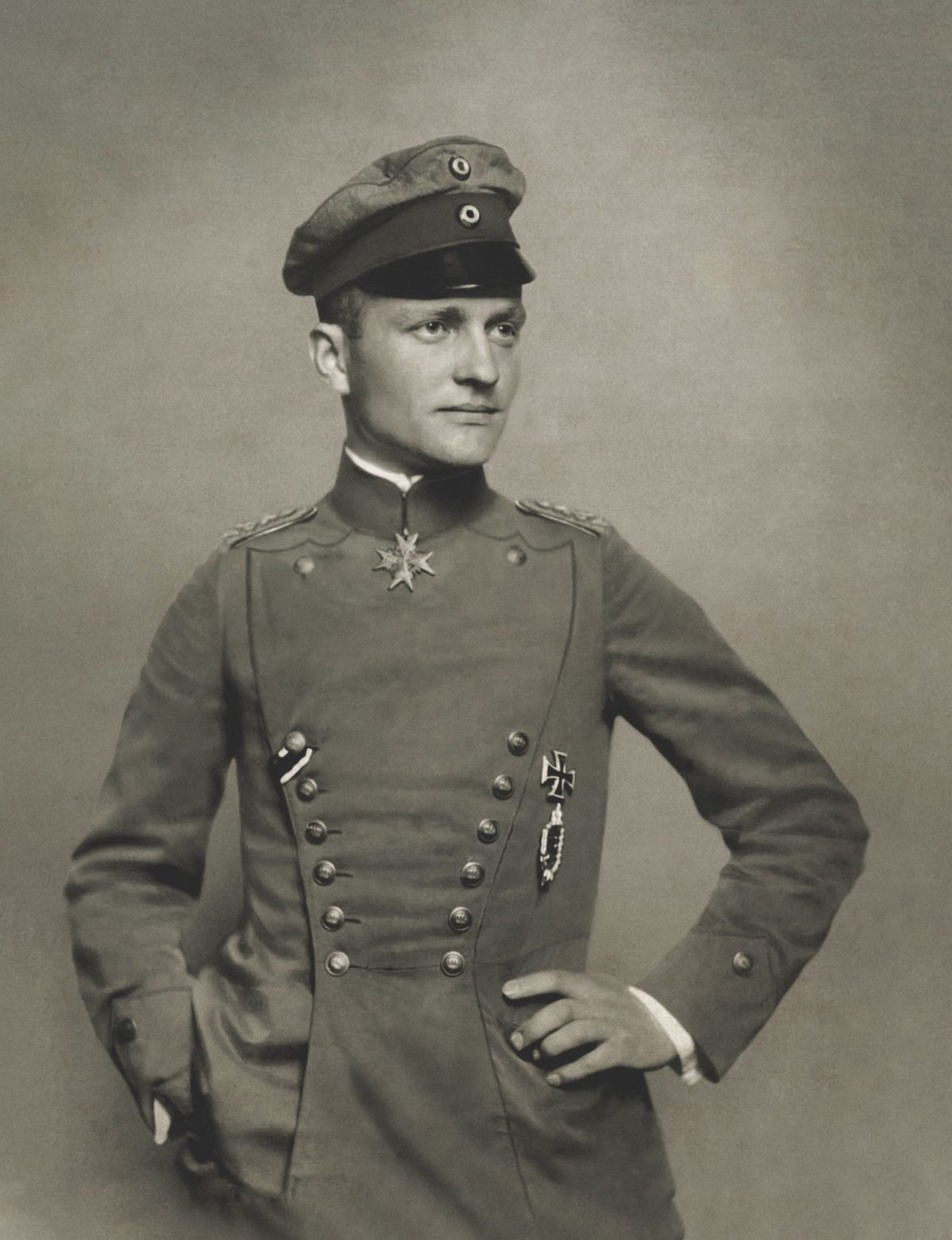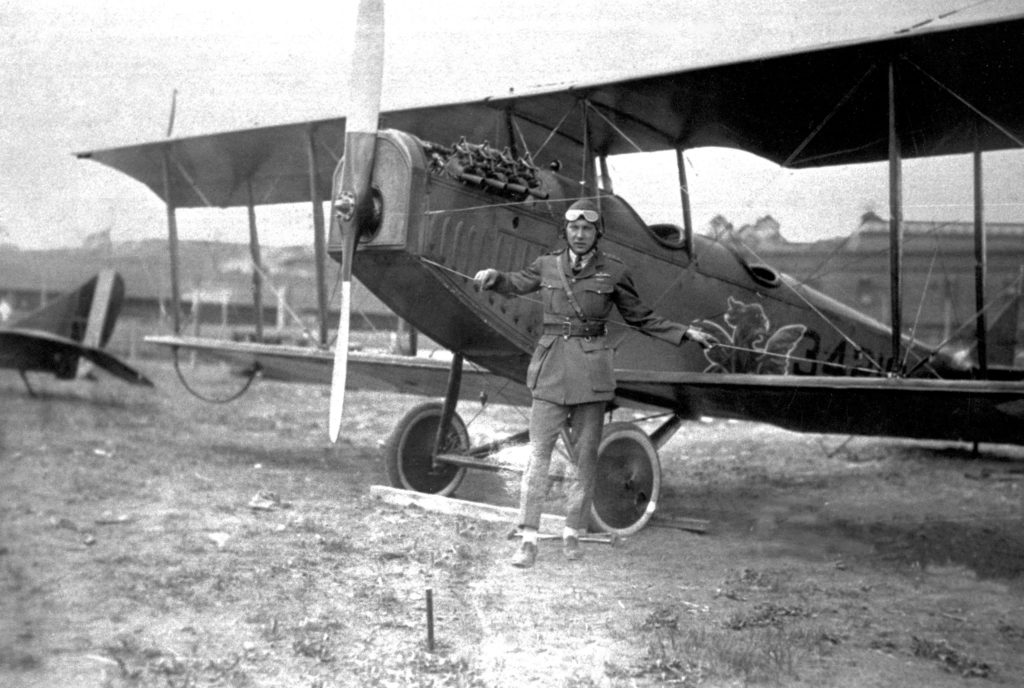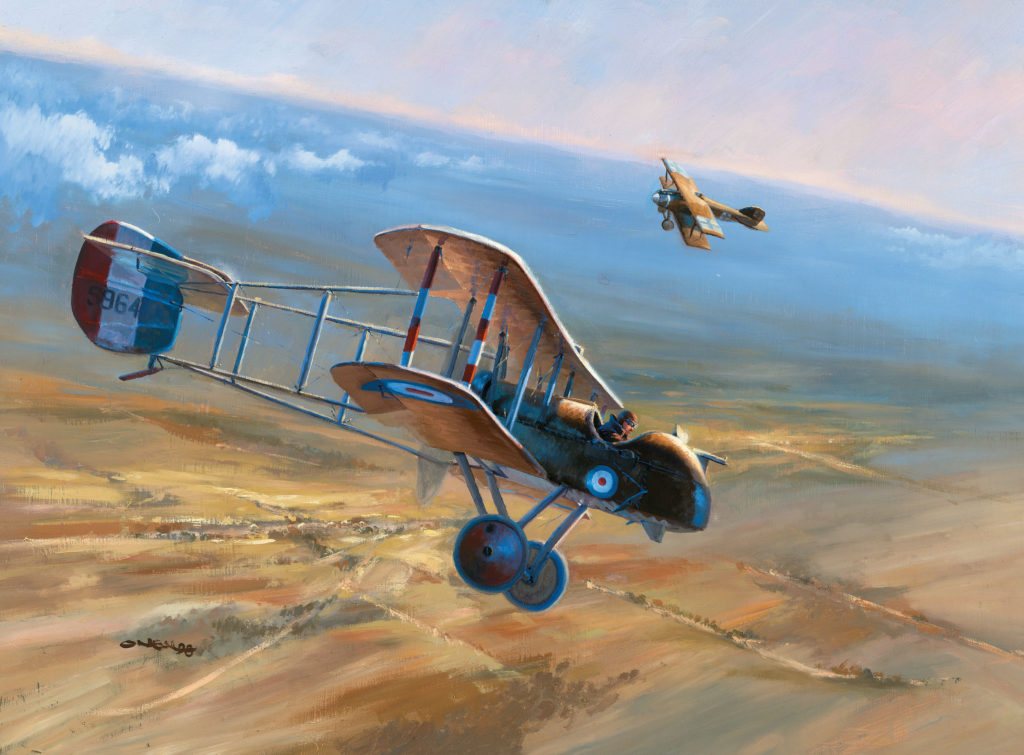Rittmeister (cavalry captain) Manfred Freiherr von Richthofen (May 2, 1892-April 21, 1918), known from the color he painted his fighter planes as “The Red Baron” to his allied enemies (to fellow Germans he was “der rote Kampfflieger”—“the Red Battle Flyer,” or “the Red Fighter Pilot”), was the Great War’s famed “Ace of Aces.” Between September 17, 1916, and April 20, 1918, Richthofen scored 80 officially credited victories before being killed by ground fire (most likely fired by an Australian machine gunner, Sergeant Cedric Popkin) near Morlancourt, France, on April 21, 1918. He was 11 days short of his 26th birthday.
Richthofen’s 200-page memoir, written and published in Germany following his 52nd aerial combat victory, devotes the first 60 pages or so to his family background, his entry into service as a cavalry officer, and the first year of the war.
He then recounts transferring to the Imperial German Air Service (Die Fliegertruppe) in May 1915 and his becoming a pilot. Notably, Richthofen’s journey to becoming Germany’s—and World War I’s—most famous fighter ace began with a chance meeting on a train with then-Leutnant Oswald Boelcke in October 1915. Already making a name for himself as Germany’s best fighter pilot, Boelcke replied to aerial observer (still not a certified pilot) Richthofen’s “Tell me, how do you manage it?” question in typical, straightforward Boelcke style: “Well, it is quite simple. I fly close to my man, aim well, and then of course he falls down.” Richthofen recalled, “I took great trouble to get more closely acquainted with that nice modest fellow whom I badly wanted to teach me his business.” Beginning in August 1916, that is exactly what Boelcke, by then Germany’s leading ace, would do for Richthofen. Boelcke taught the fledgling fighter pilot the principles and tactics of aerial warfare, providing Richthofen the tools and skills to become the war’s “Ace of Aces.”
By August 1916, Hauptmann (Captain) Oswald Boelcke, Germany’s preeminent ace (18 victories) following his rival Max Immelmann’s (17 victories) death on June 18, was closing in on 20 aerial victories; had received Germany’s highest valor decoration, the Orden Pour le Mérite (known as the “Blue Max”); and had written and published “Boelcke’s Dicta”—his eight principles of aerial combat, distributed throughout German air service units. Boelcke was considered the “Father of Air Combat,” and Richthofen idolized him, writing, “I am only a fighting airman, but Boelcke was a hero.” Ordered to form, train, and command what became Germany’s elite fighter pilot squadron, Jagdstaffel (Jasta) 2 in August–September 1916, Boelcke again met Richthofen while touring the Russian Front, recruiting him to join Jasta 2. Richthofen was ecstatic to join his hero’s new squadron.
This excerpt from Richthofen’s memoir, Chapter VIII (“My First English Victim”) of The Red Battle Flyer, the 1918 New York-published English translation of Richthofen’s 1917 book, Der rote Kampfflieger, recounts his tutelage under the guidance of the combat-experienced leading ace, Boelcke. Richthofen describes how he applied Boelcke’s teachings and training to achieve his first aerial victory over a British “Farman Experimental” FE.2b two-seater pusher type biplane. Later, he also details the ironic death of expert fighter pilot Boelcke, who succumbed to a midair collision with another of his pilot protégés, Leutnant Erwin Böhme, whom Boelcke had recruited for Jasta 2. The latter pilot was devastated, writing, “Why did he, the irreplaceable, have to be the victim of this blind fate, and why not I?” Without Boelcke’s teaching, training, and mentorship, there likely would have been no “Red Baron.”
We were all at the Butts [ground stationary firing range for zeroing and adjusting aircraft guns] trying our machine guns. On the previous day we had received our new aeroplanes and the next morning [Hauptmann Oswald] Boelcke was to fly with us. We were all beginners. None of us had had a success so far. Consequently everything that Boelcke told us was to us gospel truth. Every day, during the last few days, he had, as he said, shot one or two Englishmen for breakfast.
Recommended for you
The next morning, the seventeenth of September, was a gloriously fine day. It was therefore only to be expected that the English would be very active. Before we started, Boelcke repeated to us his instructions and for the first time we flew as a squadron commanded by the great man whom we followed blindly.
We had just arrived at the Front when we recognized a hostile flying squadron that was proceeding in the direction of Cambrai. Boelcke was of course the first to see it, for he saw a great deal more than ordinary mortals. Soon we understood the position and every one of us strove to follow Boelcke closely. It was clear to all of us that we should pass our first examination under the eyes of our beloved leader.
Slowly we approached the hostile squadron. It could not escape us. We had intercepted it, for we were between the Front and our opponents [prevailing westerly winds over Europe tended to drift Allied aircraft eastward over German lines]. If they wished to go back they had to pass us. We counted the hostile machines. They were seven in number. We were only five. All the Englishmen flew large bomb-carrying two-seaters. In a few seconds the dance would begin.
Boelcke had come very near the first English machine but he did not yet shoot. I followed. Close to me were my comrades. The Englishman nearest to me was traveling in a large boat [slang for the “boat” or “tub-shaped” fuselage of this pusher-type, 2-seater aircraft] painted with dark colors [it was an F.E. 2b; Lieutenant Lionel Morris (pilot); Captain Tom Rees (observer)]. I did not reflect very long but took my aim and shot. He also fired and so did I, and both of us missed our aim. A struggle began and the great point for me was to get to the rear of the fellow because I could only shoot forward with my [in-line, fuslage-mounted] gun. He was differently placed for his [open cockpit, pivot-mounted] machine gun was movable. It could fire in all directions.
Apparently, he was no beginner, for he knew exactly that his last hour had arrived at the moment when I got at the back of him. At that time, I had not yet the conviction “He must fall!” which I have now on such occasions, but on the contrary, I was curious to see whether he would fall. There is a great difference between the two feelings. When one has shot down one’s first, second or third opponent, then one begins to find out how the trick is done.
My Englishman twisted and turned, going criss-cross. I did not think for a moment that the hostile squadron contained other Englishmen who conceivably might come to the aid of their comrade. I was animated by a single thought: “The man in front of me must come down, whatever happens.” At last a favorable moment arrived. My opponent had apparently lost sight of me. Instead of twisting and turning he flew straight along. In a fraction of a second I was at his back with my excellent machine [an Albatross D.II biplane]. I give a short series of shots with my machine gun. I had gone so close that I was afraid I might dash into the Englishman. Suddenly, I nearly yelled with joy for the [pusher] propeller of the enemy machine had stopped turning. I had shot his engine to pieces; the enemy was compelled to land, for it was impossible for him to reach his own lines. The English machine was curiously swinging to and fro. Probably something had happened to the pilot. The observer was no longer visible. His machine gun was apparently deserted. Obviously, I had hit the observer and he had fallen from his seat.
The Englishman landed [his plane] close to the flying ground of one of our squadrons. I was so excited that I landed also and my eagerness was so great that I nearly smashed up my machine. The English flying machine and my own stood close together. I rushed to the English machine and saw that a lot of soldiers were running towards my enemy. When I arrived, I discovered that my assumption had been correct. I had shot the engine to pieces and both the pilot and observer were severely wounded. The observer died at once and the pilot while being transported to the nearest dressing station. I honored the fallen enemy by placing a stone on his beautiful grave.
When I came home Boelcke and my other comrades were already at breakfast. They were surprised that I had not [yet] turned up. I reported proudly that I had shot down an Englishman. All were full of joy for I was not the only victor. As usual, Boelcke had shot down an opponent for breakfast and every one of the other men also had downed an enemy for the first time.
I would mention that since that time no English squadron ventured as far as Cambrai as long as Boelcke’s squadron was there.
During my whole life I have not found a happier hunting ground than in the course of the Somme Battle. In the morning, as soon as I had got up, the first Englishmen arrived, and the last did not disappear until long after sunset. Boelcke once said that this was the El Dorado of the flying men.
There was a time when, within two months [September 2-October 26, 1916], Boelcke’s bag of machines increased from twenty to forty. We beginners had not at that time the experience of our master and we were quite satisfied when we did not get a hiding. It was an exciting period. Every time we went up we had a fight. Frequently we fought really big battles in the air. There were sometimes from forty to sixty English machines, but unfortunately the Germans were often in the minority. With them quality was more important than quantity.
Still the Englishman is a smart fellow. That we must allow. Sometimes the English came down to a very low
altitude and visited Boelcke in his quarters, upon which they threw their bombs. They absolutely challenged us to battle and never refused fighting.
We had a delightful time with our chasing [pursuit] squadron. The spirit of our leader animated all his pupils. We trusted him blindly. There was no possibility that one of us would be left behind. Such a thought was incomprehensible to us. Animated by that spirit we gaily diminished the number of our enemies.
On the day when Boelcke fell the squadron had brought down forty opponents. By now the number has been increased by more than a hundred. Boelcke’s spirit lives still among his capable successors.
One day [October 28, 1916] we were flying, once more guided by Boelcke against the enemy. We always had a wonderful feeling of security when he was with us. After all he was the one and only. The weather was very gusty and there were many clouds. There were no aeroplanes about except fighting ones.

Richthofen learned his deadly fighter pilot skills from his hero, Oswald Boelcke, known as the “Father of Air Combat.” Boelcke received his Blue Max in January 1916. (Bundesarchiv)
From a long distance we saw two impertinent Englishmen in the air who actually seemed to enjoy the terrible weather. We were six and they were two. If they had been twenty and if Boelcke had given us the signal to attack we should not have been at all surprised.
The struggle began in the usual way. Boelcke tackled the one and I the other. I had to let go because one of the German machines got in my way. I looked around and noticed Boelcke settling his victim about two hundred yards away from me.
It was the usual thing. Boelcke would shoot down his opponent and I had to look on. Close to Boelcke flew a good friend of his [Leutnant Erwin Böhme]. It was an interesting struggle. Both men were shooting. It was probable that the Englishman would fall at any moment. Suddenly I noticed an unnatural movement of the two German flying machines. Immediately I thought: Collision. I had not yet seen a collision in the air. I had imagined that it would look quite different. In reality, what happened was not a collision. The two machines merely touched one another. However, if two machines go at the tremendous pace of flying machines, the slightest contact has the effect of a violent concussion.
Boelcke drew away from his victim and descended in large curves. He did not seem to be falling, but when I saw him descending below me I noticed that part of his plane had broken off. I could not see what happened afterwards, but in the clouds he lost [his] entire plane. Now his machine was no longer steerable. It fell [within German lines near Bapaume, France] accompanied all the time by Boelcke’s faithful friend [Böhme].
When we reached home we found the report “Boelcke is dead!” had already arrived. We could scarcely realize it.
The greatest pain was, of course, felt by the man who had the misfortune to be involved in the accident.
It is a strange thing that everybody who met Boelcke imagined that he alone was his true friend. I have made the acquaintance of about forty men, each of whom imagined that he alone was Boelcke’s intimate. Each imagined that
he had the monopoly of Boelcke’s affections. Men whose names were unknown to Boelcke believed that he was particularly fond of them. This is a curious phenomenon which I have never noticed in anyone else. Boelcke had not a personal enemy. He was equally polite to everybody, making no differences.
The only one who was perhaps more intimate with him than the others was the very man who had the misfortune to be in the accident which caused his death.
Nothing happens without God’s will. That is the only consolation which any of us can put to our souls during this war.

this article first appeared in military history quarterly
Facebook: @MHQmag | Twitter: @MHQMagazine







